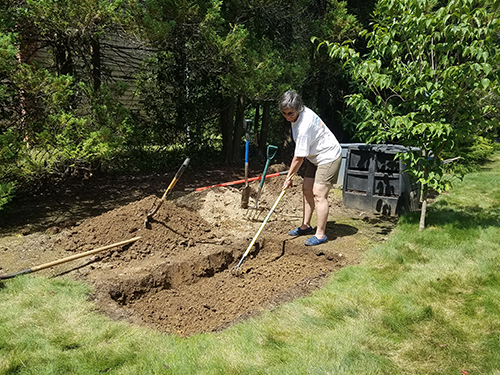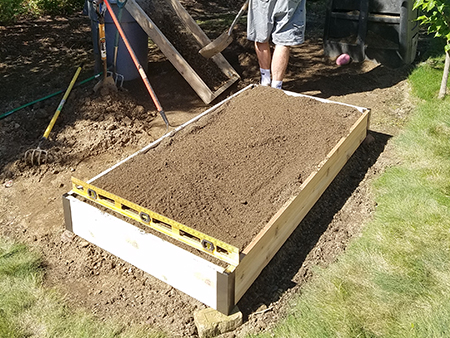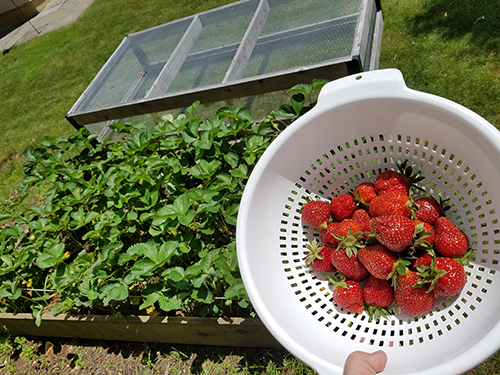
Fact Sheet FS1328
Summary of Critical Points to Consider
Raised beds are a solution for a variety of gardening challenges. Contaminated soil, poor drainage, and physical accessibility for the gardener are some of the problems that can be addressed by using raised beds.
However, raised beds also have their own challenges. One of the most frequent—based on questions to the Rutgers Soil Testing Lab and Cooperative Extension county offices—is the ‘quality’ of the soil used in raised beds. The proper selection of soil can directly impact the sustainability (low-input and worry-free) of the site for the long-term management and health of plants grown in raised beds.
Improve Native Soils When Possible to Use in Raised Beds
Some gardeners may have the misconception that they need beds composed of compost/organic matter (or other “soilless” growing media) to raise "organic" produce. Labeling of “topsoil” or soil amendment products as “organic” contributes to this misconception. The concept of organic production has more to do with sustainability, mimicking natural ecosystems, and minimizing inputs from off-site locations. It emphasizes care of the soil—its fertility, biology, and structure—as well as avoiding use of artificial/manufactured products. Utilizing the on-site, native soil in raised beds fits this basic concept for an organic production system. Even when on-site soil would benefit from organic-matter amendments (like compost), it should not be rejected for planting without good reason.
In contrast to many commercial products labelled as “soil,” organic matter is a relatively small (although important) fraction of a natural, healthy mineral soil. Soil organic matter content of 3–5% (by weight) is usually considered “high” for native mineral soils in New Jersey, and more than 10% is not recommended for general landscape or garden use. See fact sheets FS901, Topsoil Suitable for Landscape Use, and FS1136, Soil Organic Matter Level and Interpretation.
Organic vs. Organic
The word “organic” has several meanings or uses. The traditional term used in chemistry refers to compounds that contain carbon (C) and usually hydrogen and are produced by living organisms [the definition now includes manufactured substances like plastics]. In this sense of the word, a soil can be considered organic if it is composed primarily of partially decomposed plant remains. Natural organic soils (“Histosols”) develop in wetlands or cold regions where decomposition is inhibited by the environmental conditions. Kitchen scrap and yard waste composts are artificially produced organic soils; composts can also include animal waste products such as manure.
Organic gardening or farming refers to agricultural systems using only natural products of plant, animal, or geologic origin (as opposed to manufactured or highly processed amendments). Organic production of agricultural commodities recognizes the importance of “healthy” soil. Because use of the term “organic” is regulated for marketing purposes, agricultural products can be labelled as organic (“OMRI-approved” referring to Organic Materials Review Institute), but this definition of the term would not apply to soil. When considering what is “natural,” keep in mind that most terrestrial plants and nearly all crop species have evolved and thrive in mineral soil—defined as having less than 20% organic matter and usually having less than 10% organic matter (by weight).
Components of Natural, Mineral Soils vs. Organic-Based Growing Media
Most of Earth's terrestrial surface is covered by a porous layer of mineral soil, consisting primarily of fine fragments of rocks (minerals); the size distribution of the mineral particles in soil is characterized by its soil texture, or percentages of sand (0.05–2 mm particle size), silt (0.002–0.05 mm), and clay (< 0.002 mm). The minerals weather to release nutrient ions, and pores (spaces) among the soil particles are ecologically important, supporting plant growth, allowing room for root growth, providing habitat for soil organisms, and allowing for exchange of water and air. Organic matter, contributed by living and dead organisms, enhances the mineral (inorganic) qualities of the soil but usually amounts to only a small percentage of the soil mass. There is great variability of soil characteristics across the landscape and with depth due to geologic factors (parent material), climate variations, types and actions of organisms, differences in topography, and time. Differences in soil “type” are recognized and judged in terms of suitability for various uses, and nearly all can be managed and improved to produce agricultural commodities.
On the other end of a spectrum are organic growing media, which are predominantly composed of fragments of organic materials, either harvested or mined from peat bogs or as byproducts of forestry or other industries, and/or compost from various sources. These organic growing media products are often used in pots, window boxes, and other containers due to light weight and water storage/drainage characteristics. Product names can be confusing: Potting Soil, Container Mix, Garden Soil, Topsoil, Humus; check the label to determine ingredients of the bag. Only rarely will bagged products contain a mineral soil component. However, these products can be a good amendment to mineral soils that are low in organic matter due to overuse or loss of the natural topsoil.
Case for Utilizing on-Site, Native Soil
Growing plants in mineral soil is more natural than growing in organic growing media. Although organic soils do exist in nature, they are found in wetlands (or other sites where conditions limit the decomposition of organic matter) and favor plants that tolerate those wet conditions. Most of the Earth’s terrestrial landscape is based on mineral soils, and most food crops and ornamentals evolved in mineral soil. The mineral component of soil provides a significant contribution to plant nutrition in most natural and managed ecosystems. As they weather, soil minerals provide a slow but steady supply of certain nutrients which may not be found in high enough concentration in organic matter sources.
In cases of poor soils on site, consider efforts to improve their condition rather than covering or replacing them. Soil test recommendations will help to improve several aspects of soil quality (e.g., soil pH and nutrient deficiencies). Compaction problems can be alleviated by physical means, and erosion/sedimentation problems also must be corrected. Amending soils with organic matter is a common recommendation to improve soil—enhancing fertility and physical condition (tilth), assuming that soil organic matter content is depleted in the first place (common in agricultural and otherwise disturbed soils). This is where the bagged "topsoil" products that are actually organic matter will come to good use. A general recommendation is to add 1–2 inches of compost or other organic matter source on the surface and mix into a 6-inch depth of soil. This in itself will often create a positive feedback loop as the added organic matter enhances growth of vegetation and fuels the soil food web to accumulate more organic matter over the long term.
When on-site soil truly is not suitable for food production because of contamination issues or the need to build up in elevation to improve drainage or accessibility, seeking out a source of quality mineral soil/topsoil (usually in stockpiles to be transported by truck) from a reputable landscape supply vendor is recommended. Neighbors, friends, relatives, and various internet resources can be useful in identifying reputable suppliers. Contact the company for history, sources of materials, and references. Topsoil suppliers should be able to provide soil test reports for you to evaluate product quality. See fact sheet FS901, Topsoil Suitable for Landscape Use. The blended topsoil products available from stockpiles are likely to contain compost or other organic matter amendment but still have a large proportion of mineral matter as well. Mineral-based soils will provide a more natural growing medium, imparting structural support (depending on disturbance level) to reduce settling and compaction, as well as bestowing long-term fertility benefits.
Use of Organic Growing Media and Organic Amendments
Raised beds are often considered container plantings and are filled with garden store products labeled as potting soil, garden soil, or “topsoil.” While there are a few exceptions, many of these bagged products are exclusively organic materials. Label ingredients may include: “arbor fines” or “forest products,” wood bark, sphagnum peat moss and/or reed sedge peat, coconut husk fiber (coir), and/or composts of various kinds and quality.
The term organic is used here and throughout the rest of the document to mean "relating to or derived from living matter" as opposed to the definition "(of food or farming methods) produced or involving production without the use of chemical fertilizers, pesticides, or other artificial agents."
Peat, coir, and woody ingredients provide physical structure to the growing media and are able to absorb and store water to varying degrees, but these components add little benefit in terms of plant nutrition (in absence of added fertilizer nutrients). On the other hand, many types of compost are beneficial in terms of nutrient supply to plants, but the fertility value depends on the raw material used (feed source) and many composting conditions such as age (maturity or ‘curing’), leaching, aeration, etc. Also, the amount and continued supply of nutrients may not coincide with plant needs over the long term. Therefore, intensive management of fertility is needed throughout a growing season when organic growing media are used.
Rarely do bagged “soil” products actually contain mineral soil. Some include sand as an ingredient to benefit drainage and resistance to compaction; however, sand adds greatly to the weight of the product while contributing very little to the soil fertility component. Read the ingredients label of bagged soil products to know what you are buying and adding to your landscape. When using the bed to grow fruits or vegetables, avoid using any product that contains sewage biosolids/sludge to minimize health risks. Be wary of products that do not define all of the ingredients. If possible, examine the product and avoid those that have a strong ammonia odor in the product. A strong smell of ammonia could indicate that ingredients are not properly composted.
Potential Problems with Use of Organic Growing Media Alone
Initial success with organic growing media is not unusual. Many nutrients are released during the decomposition/composting process (“mineralization” refers to plant-available, inorganic ions being released from organic form during decomposition). The available nutrients are loosely held, adsorbed to the organic matter and easily taken up by plant roots, leading to compost’s “black gold” moniker. After the first flush of nutrient release from “fresh” compost, the compost can be considered a slow-release fertilizer because flux of nutrients from organic matter depends on ongoing—but now slower—decomposition rates. Environmental conditions (temperature, moisture, aeration) therefore also play a role in short-term fertility from compost. Consider also that timing of nutrient release may not correspond well to a plant’s need at certain times in its growth cycle. With continued decomposition, the supply and balance of nutrients released from the organic matter becomes unfavorable to sustain optimum vegetative growth, flowering, and/or fruit production. As with the recalcitrant (resistant to decomposition) forms of organic matter (peat moss, woody materials), complete fertilizers become necessary.
Even with fertilizer amendments, gardeners often begin to experience poor growth of their crops and/or low yields after several years of use in raised beds filled with (only) organic growing media. There are a number of possible contributing factors, described below.
Potassium is a macronutrient (relatively high amounts needed) that can be a particular problem in organic growing media because it does not exist as part of any organic molecule in living tissue; instead, it is in ionic form dissolved in solution such as cell cytoplasm and xylem sap. When the tissue dies, the potassium is released in soluble form, some of which may be retained in the compost but otherwise is lost by leaching. The result is that organic matter cannot be considered a long-term source of potassium.
In addition, deficiencies of the micronutrient copper are common in peaty and otherwise high-organic matter soils. Copper is “tied up” (tightly complexed) by organic matter, making even added copper (as fertilizer) unavailable for plant uptake.
The continuing decomposition processes of organic matter/organic growing media have physical consequences as well as the effects on fertility. Organic matter loses its original physical structure, resulting in volume reduction. This is similar to what happens early in the composting process and during the “subsidence” of natural organic soils when drained (such as with agricultural land in the Everglades region of Florida). Therefore, continual additions may need to be made to maintain appropriate volume of the organic growing media for the plant roots. Recalcitrant forms of organic matter, such as sphagnum peat moss and wood chips, will retain physical structure more readily.
Loss of original physical structure of organic matter, initially 'fluffy' and porous, also implies that what remains of the organic matter will develop a paste-like consistency, sometimes described as greasy. In natural mineral soils, highly decomposed organic matter (“humus”) occurs mainly as coatings on mineral surfaces. Without mineral particles to adhere to as coatings, the organic matter collapses or slumps and becomes “mucky.” There is less porosity, and this in turn affects drainage, water-holding capacity, and the ability of air to diffuse (aeration).
Humus is another term sometimes used on bag labels for retail organic matter products. Soil scientists use this term for highly decomposed and recalcitrant organic matter in the range of hundreds to thousands of years old.
While these conditions may take some time to develop, the cascading consequences create an unfavorable growing medium. Reduced volume of large pores results in slower drainage, and water-holding capacity increases to an excessive level. This further reduces the aeration of the organic soil, since water effectively blocks most gas diffusion both in (oxygen, O2) and out (carbon dioxide, CO2). In addition to decreased porosity as the organic matter decomposes, the flourishing biological activity stimulated by the organic matter depletes soil O2, competing with plant roots for the supply of trapped or slowly diffusing O2. Plant roots need O2 to respire and properly metabolize, while in anaerobic soils, most terrestrial plants will “suffocate.” Anaerobic conditions are detrimental to most of the biological food web organisms in soil, and instead anaerobic bacteria will become more active, potentially resulting in accumulation of toxic metabolites.
These physical changes that occur in decomposing organic growing media—reduced porosity, poor aeration, and excess water content—have another consequence. Risk of plant disease is increased due to interruption of proper root function (affecting host susceptibility) and enhanced population and/or mobility of soil-borne disease organisms in wet soil (increasing virulence of pathogen). In short, poorly structured, wet soil creates the environmental conditions that favor plant disease.
While organic growing media tend to have greater water-holding capacity than mineral soils, there can be a seemingly contradictory effect if they dry, such as might happen at the surface in mid-summer sun. When moisture is baked out of the soil, the organic matter exhibits hydrophobic properties; that is, it tends to repel water rather than absorbing it readily. Water may bead up on the surface and run off. In fact, with its lightweight character, organic growing media can be eroded by flotation in the runoff water. Walls of a raised bed will usually prevent erosion, but resistance to wetting up of the bed can limit absorption and availability of water in the days following.
Analyzing Organic Growing Media and Composts
“Soils” comprised of mostly organic matter are not tested in the same way as mineral soils; that is why soil sampling instructions from the Rutgers Soil Testing Lab warn "Do not use for potting soil, compost, or other non-mineral growing media; use organic media analysis questionnaire instead.” Organic growing media require a different method to analyze their characteristics. Organic growing media and compost are analyzed using the Saturated Media Extract (SME) technique rather than the Mehlich-3 chemical extraction, which is used in New Jersey for mineral soils. Because they are more labor- and time-intensive, the SME procedure and associated analyses require a higher fee as well. Furthermore, recommendations are less specific than with mineral-based soil test recommendations. Unpredictable, slow release, and low supply power of organic-matter nutrients in typical organic growing media tend to make frequent doses of fertilizer nutrients necessary. On the other hand, fresh composts may have excessive nutrients and result in an osmotic “burn” hazard. Acidity/pH may vary from moderately acidic (sphagnum peat moss; anaerobic “sour” composts) to alkaline (many mature composts). As with soil, testing is recommended to determine properties and develop management plans for these organic growing media.
Conclusions
There are a variety of raised bed situations that will differ in challenges and possible solutions. When feasible, mineral soils will often present the most natural and sustainable growing media, enhanced with fertilizer and/or organic matter if necessary. While the common response to building raised beds is to complete them with organic growing media, there is evidence that this may lead to greater management needs over the long term. Understanding the challenges helps us to avoid or alleviate most problems.
References
Photo credit: Three across (l-r): Photos of raised bed preparation (excavating soil to blend with compost, raised bed frame filled with amended topsoil) and strawberry crop, courtesy S. Murphy, NJAES.
December 2020
Copyright © 2025 Rutgers, The State University of New Jersey. All rights reserved.
For more information: njaes.rutgers.edu.
Cooperating Agencies: Rutgers, The State University of New Jersey, U.S. Department of Agriculture, and Boards of County Commissioners. Rutgers Cooperative Extension, a unit of the Rutgers New Jersey Agricultural Experiment Station, is an equal opportunity program provider and employer.



